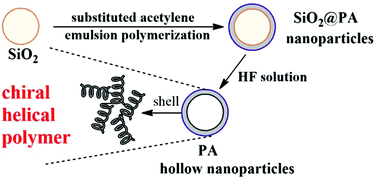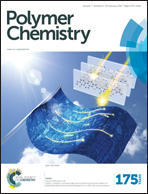Optically active hollow nanoparticles constructed by chirally helical substituted polyacetylene†
Abstract
Numerous vinyl polymer-based hollow particles have been intensively explored, however it still remains a big academic challenge to prepare their counterparts derived from acetylenics. Excitingly, we achieved the first hollow nanoparticles constructed by helical substituted polyacetylene through the seed emulsion polymerization approach. Alkynylated SiO2 nanoparticles served as seed emulsion, in which a substituted acetylene monomer (chiral M1 or achiral M2) and a cross-linker underwent emulsion copolymerization by using (nbd)Rh+B−(C6H5)4 as a catalyst. The emulsion polymerizations led to core/shell structured nanoparticles. After etching the SiO2 cores, the core/shell nanoparticles were transformed into hollow architectures. Both the core/shell and hollow particles were confirmed by TEM. CD and UV-vis absorption spectra demonstrated the helical conformations of the substituted polyacetylenes forming the core/shell and hollow nanoparticles. Thermogravimetric analysis showed the high stability of the hollow nanoparticles. The present study establishes a novel class of hollow particles, in particular the ones showing optical activity. The preparation strategy provides a versatile platform for developing analogous hollow particles derived from acetylenics.


 Please wait while we load your content...
Please wait while we load your content...